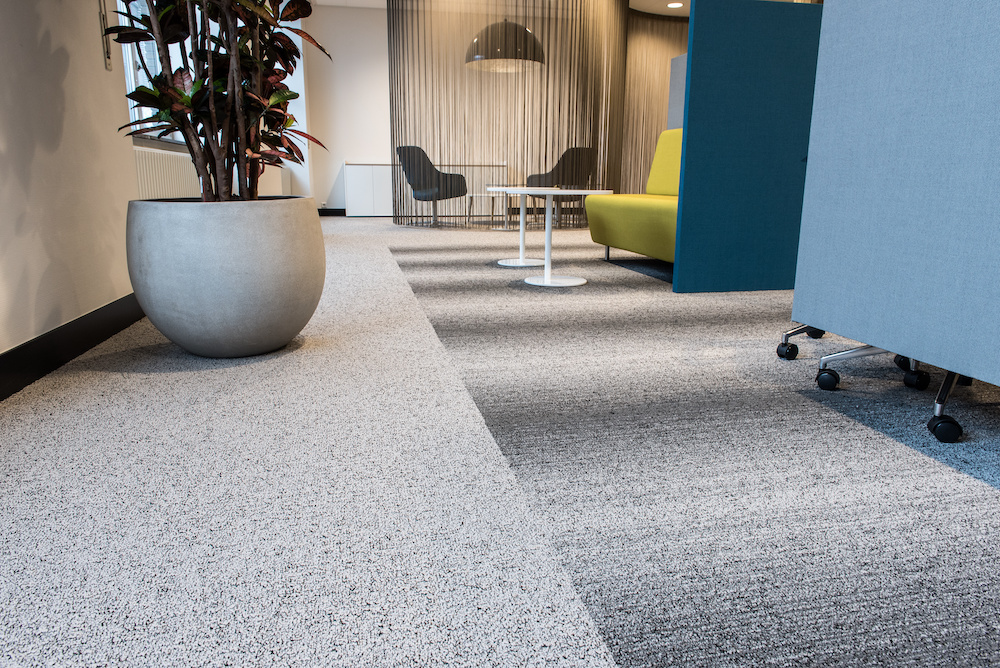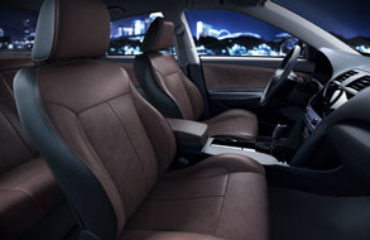Choosing the right flooring is essential for designing the perfect office space. One of the best options for office flooring is commercial carpet. Office carpet provides a durable, stylish, and easy-to-maintain floor that can last for over a decade in your office or commercial building.
If you are designing an office space from a blank slate or remodeling an existing commercial property, you should familiarize yourself with the basics of commercial carpeting. Learn why office carpet is an excellent choice for your commercial space and how to decide on the right option with our complete guide to choosing the best carpets for your office.
Why Use Office Carpet in Your Office Space
When choosing flooring for your office space, you may wonder why you should choose commercial carpet over other options. The biggest reason for choosing an office carpet is that it allows you to choose from various designs, colors, and materials that can help you match your office space with your company brand.
Flooring like wood, concrete, or laminate doesn’t offer as much flexibility. Unlike these types of flooring, commercial carpet also provides a much more comfortable and pleasant experience for people who work and visit the office space.
Carpeting offers a sense of warmth and intimacy that other types of flooring can’t provide and adds a high-quality feel to the space that might be lacking with cheap laminate or concrete.
Office carpet makes an excellent choice for your commercial space because of its customizability. You can choose different colors, fiber types, and lengths to get the right carpet for your high traffic office areas like hallways, entryways, workstations, and conference rooms. Putting in a high-quality office carpet keeps your commercial area looking great for years to come.
Choosing the Right Office Carpet for Your Commercial Area
To choose the perfect office carpet for your commercial space, you’ll want to consider several elements regarding your office, such as how you plan to use the space, how long the carpet needs to last, and what aesthetic you want to achieve. Ask yourself the following questions to help narrow down and choose the right carpet.
How do you plan to use the office space?
Before deciding on a commercial carpet, consider how you plan to use your office space. Does your business follow a typical office floor plan with workstations, hallways, and conference areas? Or do your employees constantly move around throughout the day? Do you plan to have visitors to the office? Do you expect daily deliveries or movement of heavy items? Each of these elements can play a part in helping you determine which type of carpet you need.
For example, if you bring high-powered clients into your office, you’ll want to choose a high-quality carpet with a design that represents your company. If you are simply looking for a middle-of-the-road carpet that can stand up to office chairs and desks, you may opt for a carpet with a subtle design and durable qualities.
What look are you going for: Consider the design
Think about the look you want to create for your office space when choosing a carpet. Consider whether you prefer a carpet with short pile or long pile fibers and if you like the look of looped or non-looped tufting. Short pile, cut fibers create a more efficient, industrial look, while long-pile fibers and looping can create a more inviting feel.
Also, consider the color and pattern of the look you want to achieve. Interior office design colors like blue, gray, green, and yellow can help induce a particular mood for your commercial space. You may opt for gray or blue carpeting for a calming, professional effect or a brighter yellow or green to energize the space and promote creativity.
What’s your ideal life expectancy for the carpet?
Consider how long you need the carpet to last when choosing a commercial carpet. If you only plan to operate in the space for a short time, say several months to a few years, you might opt for a more affordable, less high-quality office carpet. A carpet with olefin or polypropylene fibers may offer you the most short-term, cost-effective option.
For commercial areas you plan to use for many years, you’ll want to choose a durable, high-quality commercial carpet. Nylon is a popular carpet fiber choice for long-term commercial spaces, and it tends to work well in high-traffic areas.
How does your office carpet need to perform?
As you consider office carpet options, think about how the carpet needs to perform. How often will it need to hold up to spills or stains? What types of substances might come in contact with the carpet? Nylon, olefin, and polypropylene carpet hold up reasonably well to typical office-type stains such as coffee spills, mud, or other food or drink stains.
Carpet performance can also refer to how it holds its shape under constant foot traffic or pressure from furniture or office equipment. Low-pile nylon is durable and holds its shape well in most office areas. Wool may also provide a high level of durability for your commercial space, but it may be a pricer option. Olefin fibers work decently well in high-traffic areas, but this type of carpet may perform better in an area with light foot traffic.
Hard Flooring Options vs. Commercial Carpet: Which is Better?
Commercial carpeting offers several benefits over hard flooring options for your office. Office carpet gives you design versatility, helps control the office temperature, and provides a safer walking environment for your staff. It’s also cheaper than some options like hardwood flooring, making it a good choice for office spaces on a budget.
Aesthetic versatility
Many commercial carpet manufacturers use solution-dyed techniques that allow for a multitude of colors and patterns in the product. Unlike traditional dye methods, solution-dying adds pigment to the base chemicals that make up synthetic fibers like olefin and nylon.
With this technique, fibers are already colored, allowing the manufacturer to weave them into any pattern. When you use office carpets over other options, you have more choices that meet your desired office aesthetic.
Safe environment
Properly installed carpet helps create a safe walking environment for people in the office. Hard flooring typically becomes slippery when wet and doesn’t provide friction for the soles of shoes.
Carpet minimizes the risk of tripping, slipping, and falling, and its fibers help provide traction for all types of footwear. Carpet also provides a safer environment for the body because it absorbs the impact of a person’s foot hitting the floor when they walk over a hard option.
Temperature control
Carpet fiber acts as an extra layer of insulation for your office environment. This helps create a warmer, cozier feel in the office for employees or visitors. The insulation can also help you save on heating costs in a colder climate. Your commercial carpet can help trap the heat inside the office, keeping the temperature stable without adjusting the thermostat.
Better acoustics and noise control
Opting for carpet over a hard floor option creates a more pleasant office space with less residual noise. Hard flooring reflects noises such as footsteps, moving chairs, keyboard clicking, and voices. Without carpet to absorb the sound, the people who work and visit the commercial area may have to deal with distracting sounds throughout the day. By choosing an office carpet to muffle these noises, you can create a less distracting office space.
If you anticipate a lot of movement and vocalization in your office space, opt for a high-quality carpet with sturdy backing and wool fibers. Quieter offices should experience a pleasant noise level with a commercial carpet with a high mass of nylon or olefin fibers.
Cost
The cost of commercial carpeting varies based on the design, brand, and material you choose for your office. On average, commercial carpeting costs about $3 per square foot. Hardwood floors cost around $5 per square foot, while concrete flooring can range from $2 to $30 per square foot, depending on customization and finish.
Because commercial carpet lasts for several years, is stain resistant, and stands up to foot traffic, it is often a cost-effective choice versus other options.
How Much Does Office Carpet Cost?
The cost of commercial carpet varies significantly based on several factors. These include:
- Type of fiber – wool is typically the most expensive, followed by nylon, olefin, polypropylene
- Design – custom design or patterned carpet is more expensive than solid-colored carpet
- Backing – manufacturers may use latex, bitumen, or PVC, with latex being the most expensive option
When choosing your commercial carpet, compare your options and come prepared with your office carpet budget. It’s also helpful to consult with a professional carpet cleaning company to learn what type of cleaning can elongate the life of your office carpet.
They can recommend carpet cleaning extracting equipment or provide you with professional cleaning services using dry cleaning methods to care for your commercial carpet.
Maintain Your Office Carpet With Professional Carpet Cleaning Services From DryMaster
Choosing the right carpeting for your office is essential to creating a work-friendly space that looks great and performs well over time. For more information on selecting the right carpet for your office or to discover the best ways to clean commercial carpeting, contact a DryMaster Solutions affiliate.
Our affiliate program provides access to exceptional carpet cleaning training and equipment so they can offer their clients high-quality carpet cleaning services and tips.




